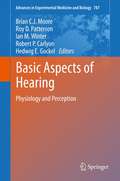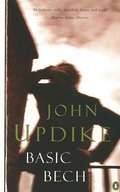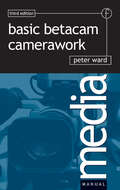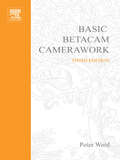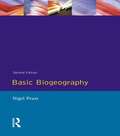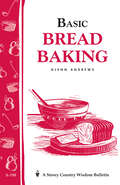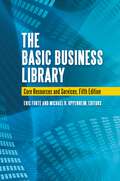- Table View
- List View
Basic Aspects of Hearing: Physiology and Perception
by Brian C. J. Moore, Roy D. Patterson, Ian M. Winter, Robert P. Carlyon and Hedwig E GockelThe International Symposium on Hearing is a highly-prestigious, triennial event where world-class scientists present and discuss the most recent advances in the field of hearing research in animals and humans. Presented papers range from basic to applied research, and are of interest neuroscientists, otolaryngologists, psychologists, and artificial intelligence researchers. Basic Aspects of Hearing: Physiology and Perception includes the best papers from the 2012 International Symposium on Hearing. Over 50 chapters focus on the relationship between auditory physiology, psychoacoustics, and computational modeling.
Basic Aspects of Psychoanalytic Group Therapy (Routledge Library Editions: Group Therapy)
by Peter KutterFirst published in English in 1982 and based on more than five years of experience with therapy groups in the author’s own practice, this book aims to introduce the reader to psychoanalytic group therapy. Assuming little previous knowledge, it presents the subject in a progressive and illustrative way, and gives a central place to case material that was otherwise rarely published. Theory remains in the background and serves only to direct light on to problems which arise in practice, such as working through the early mother child relationship and the Oedipus complex in the group situation, the theory of the group process, and the various forms of transference, including the group conductor’s counter-transference. The book’s special value consists in its practical non-dogmatic orientation, in its integration of a variety of conceptions about groups, in its vividly illustrative case presentations, and in the open discussion of the problem of counter-transference. Written in non-technical language, it gives a lively picture of how ‘the business of psychoanalytic group therapy’ is managed, and will be of value to group analysts in practice and in training, as well as those interested in a more general way in psychoanalytic group therapy and what it is all about.
Basic Aspects of Psychoanalytic Group Therapy (Routledge Library Editions: Group Therapy)
by Peter KutterFirst published in English in 1982 and based on more than five years of experience with therapy groups in the author’s own practice, this book aims to introduce the reader to psychoanalytic group therapy. Assuming little previous knowledge, it presents the subject in a progressive and illustrative way, and gives a central place to case material that was otherwise rarely published. Theory remains in the background and serves only to direct light on to problems which arise in practice, such as working through the early mother child relationship and the Oedipus complex in the group situation, the theory of the group process, and the various forms of transference, including the group conductor’s counter-transference. The book’s special value consists in its practical non-dogmatic orientation, in its integration of a variety of conceptions about groups, in its vividly illustrative case presentations, and in the open discussion of the problem of counter-transference. Written in non-technical language, it gives a lively picture of how ‘the business of psychoanalytic group therapy’ is managed, and will be of value to group analysts in practice and in training, as well as those interested in a more general way in psychoanalytic group therapy and what it is all about.
Basic Aspects of Receptor Biochemistry: Proceedings of the International Symposium, Vienna, Austria September 10-12, 1982 (pdf) (Journal of Neural Transmission. Supplementa #18)
by M. Goldstein K. Jellinger P. RiedererBasic Atomic Interactions of Accelerated Heavy Ions in Matter: Atomic Interactions of Heavy Ions (Springer Series on Atomic, Optical, and Plasma Physics #98)
by Inga Tolstikhina Makoto Imai Nicolas Winckler Viacheslav ShevelkoThis book provides an overview of the recent experimental and theoretical results on interactions of heavy ions with gaseous, solid and plasma targets from the perspective of atomic physics. The topics discussed comprise stopping power, multiple-electron loss and capture processes, equilibrium and non-equilibrium charge-state fractions in penetration of fast ion beams through matter including relativistic domain. It also addresses mean charge-states and equilibrium target thickness in ion-beam penetrations, isotope effects in low-energy electron capture, lifetimes of heavy ion beams, semi-empirical formulae for effective cross sections. The book is intended for researchers and graduate students working in atomic, plasma and accelerator physics.
Basic Bech: Bech a Book, Bech is Back
by John UpdikeBasic Bech combines two classic titles -- Bech: A Book and Bech is Back -- from one of John Updike's most beloved characters.Henry Bech, the celebrated author of Travel Light, has been scrutinized, canonized and vilified by reviewers, academics, critics and readers across the world. Suffering from temporary impotence and not-so-temporary writer's block, Bech finds renewed fame when he returns to his native America and Think Big, his all-time blockbuster, hits the shops . . . In these classic novels by John Updike, we return to a character as compelling and timeless as Rabbit Angstrom: the inimitable Henry Bech. Famous for his writer's block, Bech is a Jew adrift in a world of Gentiles. As he roams from one adventure to the next, he views life with a blend of wonder and cynicism that will make you laugh with delight and wince in recognition.Praise for John Updike:'Our time's greatest man of letters - as brilliant a literary critic and essayist as he was a novelist and short-story writer. His death constitutes a loss to our literature that is immeasurable' Philip Roth'Alert, funny, sensuous. Here is a writer who can do more or less as he likes' Martin Amis'One of the most protean of American writers . . . For a writer whose prose can be so lush and hyper-charged, he has always been in contact with the material detritus of everyday life' The Times'He was the ideal son of a platonic union between John Cheever and J.D. Salinger, with Nabokov attending the christening as fairy godfather' James WoodJohn Updike was born in 1932 in Shillington, Pennsylvania. He graduated from Harvard College in 1954, and spent a year in Oxford, at the Ruskin School of Drawing and Fine Art. His novels, stories, and nonfiction collections have won numerous awards, including the Pulitzer Prize, the National Book Award, the National Book Critics Circle Award, the PEN/Faulkner Award and the Howells Medal of the American Academy of Arts and Letters. He died in January 2009.
Basic Benefits And Clinical Guidelines
by David C. HadornThis book explains how clinical guidelines might be used to define health care needs and basic benefits. It discusses certain technical issues of the model proposal, including the importance of considering both health outcome evidence and patient and public preferences.
Basic Benefits And Clinical Guidelines
by David C. Hadorn Richard D. LammThis book explains how clinical guidelines might be used to define health care needs and basic benefits. It discusses certain technical issues of the model proposal, including the importance of considering both health outcome evidence and patient and public preferences.
Basic Betacam Camerawork (Media Manuals Ser.)
by Peter WardBasic Betacam Camerawork offers a complete introduction to both the analogue and digital beta camera formats: Betacam, Digital Beta, Betacam SX and DV & DVCAM. Step-by-step instructions are given covering everything from pre-recording checklists, to technical camera specifications, instruction on exposure and lighting, composition, editing and sound and techniques for different programme styles. Aimed at TV camera operators just starting out and film cameramen and women converting to video this book will also appeal to students on film and television production courses.Peter Ward is a freelance cameraman and trainer working with the International Television Training Consultancy and ex-Chairman of the Guild of Television Cameramen. He spent many years working on a variety of programmes at the BBC before becoming Head of Cameras at Television South West. Peter is author of the following books for Focal Press: Digital Video Camerawork, Picture Composition for Film and Video , Studio & Outside Broadcast Camerawork, TV Technical Operations and co-author of Multiskilling for TV Production.Basic Betacam Camerawork offers a complete introduction to both the analogue and digital beta camera formats.
Basic Betacam Camerawork
by Peter WardBasic Betacam Camerawork offers a complete introduction to both the analogue and digital beta camera formats: Betacam, Digital Beta, Betacam SX and DV & DVCAM. Step-by-step instructions are given covering everything from pre-recording checklists, to technical camera specifications, instruction on exposure and lighting, composition, editing and sound and techniques for different programme styles. Aimed at TV camera operators just starting out and film cameramen and women converting to video this book will also appeal to students on film and television production courses.Peter Ward is a freelance cameraman and trainer working with the International Television Training Consultancy and ex-Chairman of the Guild of Television Cameramen. He spent many years working on a variety of programmes at the BBC before becoming Head of Cameras at Television South West. Peter is author of the following books for Focal Press: Digital Video Camerawork, Picture Composition for Film and Video , Studio & Outside Broadcast Camerawork, TV Technical Operations and co-author of Multiskilling for TV Production.Basic Betacam Camerawork offers a complete introduction to both the analogue and digital beta camera formats.
Basic Biogeography
by N V PearsFirst published in 1985. Routledge is an imprint of Taylor & Francis, an informa company.
Basic Biogeography
by N V PearsFirst published in 1985. Routledge is an imprint of Taylor & Francis, an informa company.
Basic Biology of New Developments in Biotechnology (Basic Life Sciences #25)
by Alexander HollaenderAllen I. Laskin Biosciences Research Exxon Research and Engineering Company Linden, New Jersey I was contacted in the Fall of 1981 by Professors Martin Dworkin and Palmer Rogers, of the University of Minnesota and asked to participate in the orgnization of the 1983 conference in the series, "Interface Between Biology and Medicine". They and the other members of the advisory committee had the vision to realize that this was a time to depart somewhat from the traditional theme, since one of the major areas of interest in the biological and related sciences these days is that of biotechnology in a broader sense than its impact on medicine alone. In designing the format of the Conference, we considered another factor. There has been a plethora of conferences, symposia, and meetings on biotechnology over the past few years, and the faces and topics have become rather familiar. There has been a strong emphasis on the development of the technology and the "biotechnology industry"; less attention has been paid to the science behind it. One might get the impression from some of these meetings and from the popular press that biotechnology has just recently sprung up, apparently full blown; the very fundamental scientific discoveries and the great body of 1 ALLEN I. LASKIN 2 continuing research that forms that basis for the technology is often obscured.
Basic Bioscience Laboratory Techniques: A Pocket Guide
by Philip L.R. Bonner Alan J. HargreavesThis unique, practical, pocket-sized guide and reference provides every first year bioscience student with all they need to know to prepare reagents correctly and perform fundamental laboratory techniques. It also helps them to analyse their data and present their findings, in addition to directing the reader, via a comprehensive list of references, to relevant further reading All of the core bioscience laboratory techniques are covered including: basic calculations and the preparation of solutions; aseptic techniques; microscopy techniques; cell fractionation ; spectrophotometry; chromatography of small and large molecules: electrophoresis of proteins and nucleic acids and data analysis. In addition the book includes clear, relevant diagrams and worked examples of calculations. In short, this is a 'must-have' for all first year bioscience students struggling to get to grips with this vitally important element of their course.
Basic Bioscience Laboratory Techniques: A Pocket Guide
by Philip L.R. Bonner Alan J. HargreavesThis unique, practical, pocket-sized guide and reference provides every first year bioscience student with all they need to know to prepare reagents correctly and perform fundamental laboratory techniques. It also helps them to analyse their data and present their findings, in addition to directing the reader, via a comprehensive list of references, to relevant further reading All of the core bioscience laboratory techniques are covered including: basic calculations and the preparation of solutions; aseptic techniques; microscopy techniques; cell fractionation ; spectrophotometry; chromatography of small and large molecules: electrophoresis of proteins and nucleic acids and data analysis. In addition the book includes clear, relevant diagrams and worked examples of calculations. In short, this is a 'must-have' for all first year bioscience students struggling to get to grips with this vitally important element of their course.
Basic Bioscience Laboratory Techniques: A Pocket Guide
by Philip L.R. Bonner Alan J. HargreavesA portable and pocket-sized guide to foundational bioscience and biomedical science laboratory skills The newly revised Second Edition of Basic Bioscience Laboratory Techniques: A Pocket Guide delivers a foundational and intuitive pocket reference text that contains essential information necessary to prepare reagents, perform fundamental laboratory techniques, and analyze and interpret data. This latest edition brings new updates to health and safety considerations, points of good practice, and explains the basics of molecular work in the lab. Perfect for first year undergraduate students expected to possess or develop practical laboratory skills, this reference is intended to be accessed quickly and regularly and inform the reader's lab techniques and methods. It assumes no prior practical knowledge and offers additional material that can be found online. The book also includes: A thorough introduction to the preparation of solutions in bioscience research Comprehensive explorations of microscopy and spectrophotometry and data presentation Practical discussions of the extraction and clarification of biological material, as well as electrophoresis of proteins and nucleic acids In-depth examinations of chromatography, immunoassays, and cell culture techniques Basic Bioscience Laboratory Techniques: A Pocket Guide is an indispensable reference for first year students at the BSc level, as well as year one HND/Foundation degree students. It's also a must-read resource for international masters' students with limited laboratory experience. In addition, it is a valuable aide-memoire to UG and PG students during their laboratory project module.
Basic Bioscience Laboratory Techniques: A Pocket Guide
by Philip L.R. Bonner Alan J. HargreavesA portable and pocket-sized guide to foundational bioscience and biomedical science laboratory skills The newly revised Second Edition of Basic Bioscience Laboratory Techniques: A Pocket Guide delivers a foundational and intuitive pocket reference text that contains essential information necessary to prepare reagents, perform fundamental laboratory techniques, and analyze and interpret data. This latest edition brings new updates to health and safety considerations, points of good practice, and explains the basics of molecular work in the lab. Perfect for first year undergraduate students expected to possess or develop practical laboratory skills, this reference is intended to be accessed quickly and regularly and inform the reader's lab techniques and methods. It assumes no prior practical knowledge and offers additional material that can be found online. The book also includes: A thorough introduction to the preparation of solutions in bioscience research Comprehensive explorations of microscopy and spectrophotometry and data presentation Practical discussions of the extraction and clarification of biological material, as well as electrophoresis of proteins and nucleic acids In-depth examinations of chromatography, immunoassays, and cell culture techniques Basic Bioscience Laboratory Techniques: A Pocket Guide is an indispensable reference for first year students at the BSc level, as well as year one HND/Foundation degree students. It's also a must-read resource for international masters' students with limited laboratory experience. In addition, it is a valuable aide-memoire to UG and PG students during their laboratory project module.
Basic Biostatistics for Geneticists and Epidemiologists: A Practical Approach
by Robert C. Elston William JohnsonAnyone who attempts to read genetics or epidemiology research literature needs to understand the essentials of biostatistics. This book, a revised new edition of the successful Essentials of Biostatistics has been written to provide such an understanding to those who have little or no statistical background and who need to keep abreast of new findings in this fast moving field. Unlike many other elementary books on biostatistics, the main focus of this book is to explain basic concepts needed to understand statistical procedures. This Book: Surveys basic statistical methods used in the genetics and epidemiology literature, including maximum likelihood and least squares. Introduces methods, such as permutation testing and bootstrapping, that are becoming more widely used in both genetic and epidemiological research. Is illustrated throughout with simple examples to clarify the statistical methodology. Explains Bayes’ theorem pictorially. Features exercises, with answers to alternate questions, enabling use as a course text. Written at an elementary mathematical level so that readers with high school mathematics will find the content accessible. Graduate students studying genetic epidemiology, researchers and practitioners from genetics, epidemiology, biology, medical research and statistics will find this an invaluable introduction to statistics.
Basic Blockchain: What It Is and How It Will Transform the Way We Work and Live
by David Shrier'Makes it easy for the average business executive to understand blockchain' -- Chris Larsen, founder and chairman, Ripple'An essential tool for those looking to distinguish information from noise' -- Eva Kaili, MEP and Chair of The Committee for the Future of Science and TechnologyA revolution is under way across the globe, yet very few people understand it. Basic Blockchain will explain everything you need to know to understand the technology that will soon disrupt and revolutionise everything from financial and health services to the property market and how we vote.Born of an obscure body of research on game theory developed by NASA, originally championed by drug dealers seeking to launder ill-gotten gains, accelerated by entrepreneurs seeking to improve financial access for the poor, funded by giant corporate interests attracted to the potential for billions of dollars of cost savings, blockchain heralds a new era of financial inclusion, legal inclusion for the dispossessed and lower prices for consumers. In short, it will enact radical change on our lives.In this book, David L. Shrier, one of MIT and Oxford University's leading futurists, explains for the general reader:- The history of blockchain, its apocryphal progenitor Satoshi Nakamoto and the socioeconomic context of its origins in the 2008 financial crisis.- How blockchain works, including the core technologies that drive it such as cryptographic hashes and network theory, all described in simple, understandable terms.- The potential of blockchain, including its impact on our jobs, industry and society as a whole. Blockchain will disrupt and transform our world in profound ways. This accessible book, written by a global authority on blockchain, is the essential introduction to the next technological revolution.
Basic Book Repair Methods (Non-ser.)
by Abraham A. SchechterDon't throw them out-repair them! This practical manual shows you how to preserve cloth-bound library books. Schechter gives detailed instructions for the cleaning and mending of paper, book hinge repair, case and textblock reattachment, cloth rebacking, and retitling. He describes procedures chronologically and illustrates them with black-and-white photographs. Supply lists are provided with each procedure and a bibliography of supporting literature is also included. These simple-to-learn steps are geared primarily to nonvaluable material and can be used as easily by nonprofessionals as professionals. The book can be used as a repair manual in libraries or as a training tool.
Basic Bread Baking: Storey's Country Wisdom Bulletin A-198 (Storey Country Wisdom Bulletin)
by Glenn AndrewsSince 1973, Storey's Country Wisdom Bulletins have offered practical, hands-on instructions designed to help readers master dozens of country living skills quickly and easily. There are now more than 170 titles in this series, and their remarkable popularity reflects the common desire of country and city dwellers alike to cultivate personal independence in everyday life.
Basic Bundle Theory and K-Cohomology Invariants (Lecture Notes in Physics #726)
by Dale Husemöller Michael Joachim Branislav Jurco Martin SchottenloherBased on several recent courses given to mathematical physics students, this volume is an introduction to bundle theory. It aims to provide newcomers to the field with solid foundations in topological K-theory. A fundamental theme, emphasized in the book, centers around the gluing of local bundle data related to bundles into a global object. One renewed motivation for studying this subject, comes from quantum field theory, where topological invariants play an important role.
Basic Business Analysis and Operations Research
by R H MoleBASIC Business Analysis and Operations Research discusses how the Beginners All-purpose Symbolic Instruction Code (BASIC) can be utilized in business analysis. The book is comprised of seven chapters that tackle various topics about BASIC and business analysis. Chapters 1 and 2 provide an overview of BASIC and Operations Research. Chapter 3 covers index numbers and provides an introduction to programming in structured BASIC. The book also presents programs for Data Fitting, and then describes how a simple program can be developed to include progressive complexity. The programs for a range of computational tasks are also presented. The book also tackles Markov chains in the context of policies for preventative maintenance. The text will be of great use to undergraduate students of management, computer, technology, and science.
The Basic Business Library: Core Resources and Services
by Eric Forte Michael R. OppenheimEverything you need to know in order to start, maintain, and provide service for a business collection, and to research virtually any business topic.Now in its fifth edition, The Basic Business Library is a modern sourcebook of core resources for the business library and the business information consumers and researchers it serves. This up-to-date guide also discusses strategies for acquiring and building the business collection in a Web 2.0/3.0 world and recommended approaches to providing reference service for business research. This text includes numerous real-world examples that cover market research, investment, economics, management and marketing.This is a single-volume guide to doing business research and managing business resources and services in a multitude of library environments. Readers will gain an understanding of the nature and breadth of providers of business information; learn the types and formats of information available; become familiar with key resources and providers in major categories such as marketing, financial information, and investment; and understand how to collect, use, and provide access to business information resources.
Basic Business Statistics: A Casebook
by Dean P. Foster Robert A. Stine Richard P. WatermanPreface Statistics is seldom the most eagerly anticipated course of a business student. It typically has the reputation of being a boring, complicated, and confusing mix of mathematical formulas and computers. Our goal in writing this casebook and the companion volume (Business Analysis Using Regression) was to change that impression by showing how statistics yields insights and answers interesting business questions. Rather than dwell on underlying formulas, we show how to use statistics to answer questions. Each case study begins with a business question and concludes with an answer to that question. Formulas appear only as needed to address the questions, and we focus on the insights into the problem provided by the mathematics. The mathematics serves a purpose. The material in this casebook is organized into 11 "classes" of related case studies that develop a single, key idea of statistics. The analysis of data using statistics is seldom very straightforward, and each analysis has many nuances. Part of the appeal of statistics is this richness, this blending of substantive theories and mathematics. For newcomers, however, this blend is too rich, and they are easily overwhelmed and unable to sort out the important ideas from nuances. Although later cases in these notes suggest this complexity, we do not begin that way.
